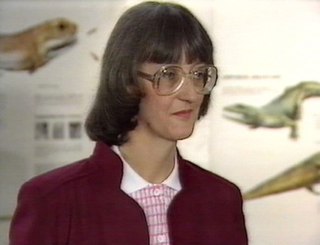Related Research Articles

John Robert Mortimer was an English corn-merchant and archaeologist who lived in Driffield, East Riding of Yorkshire.
The Yoredale Series, in geology, is a now obsolete term for a local phase of the Carboniferous rocks of the north of England, ranging in age from the Asbian Substage to the Yeadonian Substage. The term Yoredale Group is nowadays applied to the same broad suite of rocks. The name was introduced by J. Phillips on account of the typical development of the phase in Yoredale, Yorkshire.


The Boulonnais is a coastal area of northern France, around Calais and Boulogne-sur-Mer. It has a curved belt of chalk downs which run into the sea at both ends, and geologically is the east end of the Weald-Artois Anticline.
George Barrow was a British geologist.
Professor Sidney William Wooldridge CBE, FRS, FGS, geologist, geomorphologist and geographer, was a pioneer in the study of the geomorphology of south-east England and the first professor of geography at King's College London. He collaborated with Dudley Stamp and with David Linton.

The Wessex Formation is a fossil-rich English geological formation that dates from the Berriasian to Barremian stages of the Early Cretaceous. It forms part of the Wealden Group and underlies the younger Vectis Formation and overlies the Durlston Formation. The dominant lithology of this unit is mudstone with some interbedded sandstones. It is part of the strata of the Wessex Basin, exposed in both the Isle of Purbeck and the Isle of Wight. While the Purbeck sections are largely barren of vertebrate remains, the Isle of Wight sections are well known for producing the richest and most diverse fauna in Early Cretaceous Europe.

Edmund Johnston Garwood was a British geologist and President of the Geological Society of London from 1930 to 1932.

The Speeton Clay Formation (SpC) is a Lower Cretaceous geological formation in Yorkshire, northern England. Unlike the contemporaneous terrestrial Wealden Group to the south, the Speeton Clay was deposited in marine conditions. The most common fossils in the unit are belemnites, followed by ammonites and the lobster Meyeria ornata. Dinosaur remains are among the fossils that have been recovered from the formation, although none have yet been referred to a specific genus.

The Whitby Mudstone is a Toarcian geological formation in Yorkshire and Worcestershire, England. The formation, part of the Lias Group, is present in the Cleveland and Worcester Basins and the East Midlands Shelf.
Middridge Quarry is a Site of Special Scientific Interest in the Sedgefield district of County Durham, England. It is a disused quarry, situated alongside the railway line between Newton Aycliffe and Shildon, 1 km south of the village of Middridge.

Cummingella is a genus of proetid trilobite in the family Phillipsiidae that lived from the earliest Carboniferous until the last species' extinction in the Middle Permian. Fossils have been found in corresponding marine strata of Western Europe, the United Kingdom and the United States.
Margaret Chorley Crosfield was a British paleontologist and geologist.
The Aire Valley Fault is an inactive strike slip fault in Yorkshire, England. It is considered a northwestern continuation of the Morley-Campsall Fault Belt and extends northwards from the Huddersfield and Wakefield area into the South Craven fault. It is connected to the Denholme Clough Fault.

The Eyam Limestone is a geologic formation in the Peak District, England. It preserves fossils dating back to the Viséan stage of the Carboniferous period, and represents a marine environment.
Dorothy Helen Rayner was a British geologist who became an authority on the stratigraphy of the British Isles while working at University of Leeds. In 1975 she was awarded the prestigious Lyell Medal from the Geological Society of London for her contributions to the field.
The Holkerian is a sub-stage of the Viséan stage of the International Commission on Stratigraphy (ICS) geological timescale. It is one of five sub-stages commonly used in the Viséan stage within stratigraphy by British, Irish and other geologists outside the US and Asia.

Barbara Joan Pyrah (1943–2016) was a British geologist, museum curator, and illustrator.
David Williams was a noted British geologist.

Maiocercus celticus is a species of early trigonotarbid arachnid from the Upper Carboniferous of Westhoughton, Lancashire, UK. The species was first described in 1902, with a "new species" being described in 1911 which has been proven as being a junior synonym of M. celticus.
References
- ↑ Stubblefield, James (1974). "William Sawney Bisat. 1886-1973". Biographical Memoirs of Fellows of the Royal Society. 20: 27–40. doi:10.1098/rsbm.1974.0002. JSTOR 769632.
- ↑ "William Sawney Bisat".
- ↑ "Annual Report for 1940". Proceedings of the Yorkshire Geological Society. 24 (4): 235–236. 1940. doi:10.1144/pygs.24.4.235.